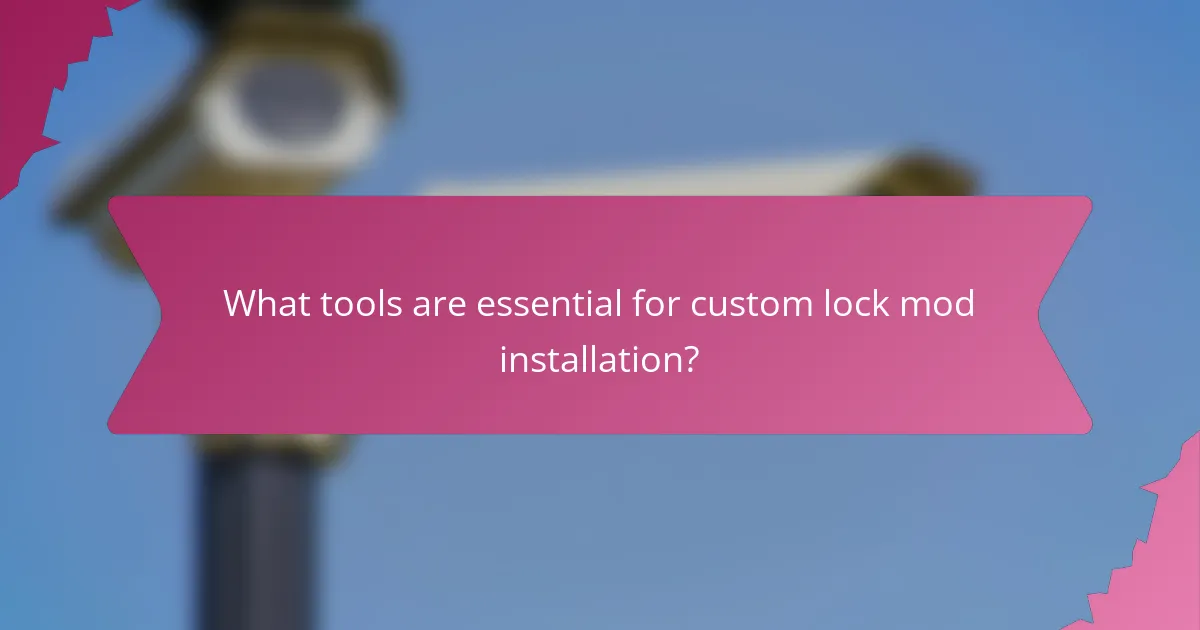Installing a custom lock mod can greatly enhance your security, but common mistakes can lead to frustrating outcomes. Issues such as inaccurate measurements, improper tool usage, and overlooking compatibility can compromise the installation process. By following a structured approach and utilizing the right tools, you can avoid these pitfalls and ensure your lock functions effectively.

What are the common mistakes in custom lock mod installation?
Common mistakes in custom lock mod installation include inaccurate measurements, improper tool usage, neglecting manufacturer guidelines, ignoring compatibility issues, and overlooking security features. Addressing these pitfalls can significantly enhance the installation process and ensure the lock functions as intended.
Incorrect measurements
Incorrect measurements can lead to a poor fit, causing locks to malfunction or become inoperable. Always double-check dimensions of both the lock and the installation area, using a reliable measuring tool. A good practice is to measure twice and cut once, ensuring accuracy before proceeding.
Consider using templates or guides provided by the manufacturer to avoid errors. If you’re unsure, consult with a professional or refer to online resources for standard measurements related to your specific lock type.
Improper tool usage
Using the wrong tools can damage the lock or the door, leading to costly repairs. Familiarize yourself with the necessary tools for installation, such as drills, screwdrivers, and chisels, and ensure they are suitable for the materials involved. For instance, using a wood drill bit on metal can result in a ruined lock.
Always follow the tool manufacturer’s instructions and safety guidelines to prevent accidents. If you’re inexperienced, consider watching tutorial videos or seeking assistance from someone with more experience in lock installations.
Neglecting manufacturer guidelines
Manufacturer guidelines are crucial for successful installation and optimal lock performance. Skipping these instructions can lead to improper setup, voiding warranties, or compromising security. Always read the manual thoroughly before starting and keep it accessible during the installation process.
Look for specific recommendations regarding installation techniques, required tools, and maintenance tips. Adhering to these guidelines ensures that the lock operates effectively and lasts longer.
Ignoring compatibility issues
Compatibility issues arise when the lock does not match the door type or existing hardware. Ensure that the lock is designed for your specific door material, thickness, and configuration. For example, a deadbolt may require a different installation approach than a standard knob lock.
Before purchasing a lock, verify its compatibility with your door by checking product specifications or consulting with a professional. This step can save time and prevent frustration during installation.
Overlooking security features
Overlooking security features can leave your property vulnerable. When selecting a custom lock mod, consider features such as anti-drill plates, pick resistance, and smart technology options. These enhancements can significantly improve the security of your home or business.
Research various lock models and their security ratings, such as those from ANSI or UL, to make informed decisions. Investing in a lock with advanced security features is essential for protecting your assets effectively.

How can I avoid mistakes during installation?
To avoid mistakes during custom lock mod installation, follow a structured approach that includes using detailed guides, the right tools, and professional advice. This will help ensure a smooth installation process and minimize errors.
Follow a detailed installation guide
Using a comprehensive installation guide is crucial for a successful custom lock mod installation. These guides provide step-by-step instructions tailored to specific lock models, which can help prevent common mistakes.
Look for guides that include diagrams or videos, as visual aids can clarify complex steps. Always ensure the guide is up-to-date and relevant to your specific lock type.
Use the right tools
Having the correct tools is essential for a smooth installation. Basic tools like screwdrivers, pliers, and a measuring tape are often necessary, but specialized tools may be required depending on the lock design.
Invest in high-quality tools to avoid damage to the lock or surrounding materials. Using the wrong tools can lead to improper installation and potential security issues.
Double-check measurements
Accurate measurements are vital during installation to ensure that the lock fits properly. Before making any cuts or adjustments, measure the door thickness and the backset to confirm compatibility with the lock mod.
Consider using a measuring tape with clear markings and double-check your measurements before proceeding. Small errors can lead to significant problems, such as misalignment or the lock not functioning correctly.
Consult with professionals
If you’re unsure about any aspect of the installation, consulting with a professional locksmith can save time and prevent costly mistakes. Professionals have the experience and knowledge to handle various lock types and installation scenarios.
Even if you plan to do the installation yourself, a brief consultation can provide valuable insights and tips tailored to your specific situation. This can enhance your confidence and ensure a more secure installation.

What tools are essential for custom lock mod installation?
Essential tools for custom lock mod installation include a power drill, screwdrivers, measuring tape, and a level tool. These tools help ensure precise installation, enhancing the functionality and security of the lock.
Power drill
A power drill is crucial for creating holes in the door or frame where the lock will be installed. Choose a drill with adjustable speed settings to control the depth and precision of your drilling.
When selecting drill bits, ensure they match the size of the screws or anchors you plan to use. A common mistake is using the wrong size, which can lead to loose fittings or damage to the door.
Screwdrivers
Screwdrivers are necessary for securing the lock components. A set that includes both flathead and Phillips head screwdrivers will cover most types of screws you encounter.
Using the correct screwdriver size is important to avoid stripping the screws. Always check that the screwdriver fits snugly into the screw head before applying force.
Measuring tape
A measuring tape is essential for accurately measuring the door and lock placement. Proper measurements ensure that the lock is installed at the correct height and alignment for optimal operation.
When measuring, double-check your dimensions to avoid errors. A common guideline is to install the lock at around 36 inches from the floor, but this can vary based on user preference and door type.
Level tool
A level tool helps ensure that the lock is installed straight, which is vital for its functionality. An uneven lock can cause it to jam or not secure properly.
To use a level, place it against the lock mechanism after installation to confirm it is even. If adjustments are needed, make them before fully securing the screws to avoid reinstallation later.

What are the best practices for ensuring a successful installation?
To ensure a successful installation of a custom lock mod, thorough preparation and testing are essential. Following best practices can help avoid common pitfalls and ensure the lock functions correctly and securely.
Pre-installation planning
Effective pre-installation planning involves assessing the compatibility of the lock mod with your existing hardware. Check the specifications of both the lock and the door to ensure they match, as mismatched components can lead to installation failures.
Gather all necessary tools and materials before starting the installation. This may include screwdrivers, a drill, and any specific components that come with the lock mod. Having everything on hand will streamline the process and reduce the likelihood of interruptions.
Testing the lock functionality
After installation, it’s crucial to test the lock functionality to confirm it operates as intended. Check both the locking and unlocking mechanisms multiple times to ensure smooth operation without any sticking or resistance.
Consider testing the lock under various conditions, such as different temperatures or after exposure to moisture, to ensure reliability. If the lock mod includes electronic components, verify that all features, such as remote access or alarms, are functioning correctly.
